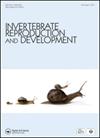喂养行为的发展和个体发育的变化在青少年早期增长Eupolymnia nesidensis(环节动物门、Terebellidae)
IF 0.8
4区 生物学
Q4 REPRODUCTIVE BIOLOGY
引用次数: 0
摘要
摘要:研究了爱奥尼亚海(地中海,意大利南部)一个种群的白蛉繁殖情况。本种在世界范围内分布,在被藻类覆盖的地中海硬底上很常见。观察发现,产卵期贯穿春季,卵磷脂营养发育发生在果冻团块内,卵直径为210 μm。12-13天后,幼鱼离开果冻团,形成一个短暂的管道,表现出一种狡猾的底栖动物行为,直接通过开口吸收食物。在幼鱼期(第100天),观察到与摄食行为相关的个体发生变化。具体地说,用完全发育的头触须的成年捕食策略取代了游动捕食行为。本文章由计算机程序翻译,如有差异,请以英文原文为准。
Development and ontogenetic changes of feeding behaviour during juvenile early growth of Eupolymnia nesidensis (Annelida, Terebellidae)
ABSTRACT Reproduction of the terebellid Eupolymnia nesidensis was investigated in a population from the Ionian Sea (Mediterranean, South Italy). This species has a worldwide distribution and is very common on Mediterranean hard substrata covered by algae. Observations revealed a spawning period across springtime with lecithotrophic development occurring inside a jelly mass, with eggs measuring 210 μm in diameter. Juveniles leave the jelly mass after 12–13 days building a transitory tube and exhibiting a vagile benthic behaviour, incorporating food directly through the mouth opening. During the juvenile stage, at day ~100, an ontogenetic shift related to feeding behaviour was observed. Specifically, the vagile feeding behaviour was replaced by the adult feeding strategy with the use of the fully developed head tentacles.
求助全文
通过发布文献求助,成功后即可免费获取论文全文。
去求助
来源期刊
CiteScore
1.90
自引率
0.00%
发文量
21
审稿时长
>12 weeks
期刊介绍:
Invertebrate Reproduction & Development ( IRD) presents original research on the reproductive and developmental biology of the Invertebrata, both embryonic and postembryonic. IRD welcomes papers reporting significant results obtained using new techniques. Encouraged topic areas include: aquaculture, physiology, biochemistry, functional morphology, phylogeny, behavioural and regulatory mechanisms, including genetic, endocrine and molecular studies. Papers containing qualitative descriptions of reproductive cycles and gametogenesis will not be considered. IRD is published in association with the International Society of Invertebrate Reproduction and Development.

 求助内容:
求助内容: 应助结果提醒方式:
应助结果提醒方式:


